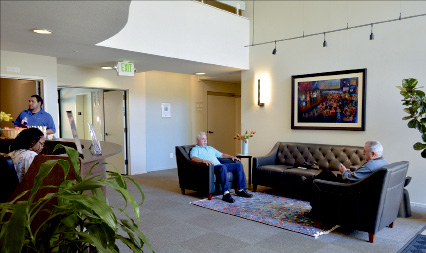
The Assistance League of Los Altos this year funded an overhaul of the entry to the Flora Lamson Hewlett Apartments Housing of Medical Emergencies, where select Stanford Health Care patients and caretakers stay during extended treatments.
When patients and families travel to Stanford Health Care for treatment, there’s no place like HOME.
The Flora Lamson Hewlett Apartments Housing of Medical Emergencies provides temporary housing for out-of-town patients undergoing treatment for a week or more. The 42-unit facility sits on Stanford University property, close to the hospital and close to others enduring similar challenges.
“When people are distressed, they’re often alone,” said Karen Nelson, Stanford Health Care’s director of social work and case management.
The hospital’s social workers help patients with financial need secure housing while they undergo treatment. HOME, Nelson said, has the unique benefit of psychosocial support.
“The common area gives people a chance to have others around and know that they’re not alone going through this,” she said. “This gives much more a feeling of home.”
HOME also eliminates the stressors of driving to appointments and finding parking. Patients and their caregivers can walk back to the housing facility to relax between appointments.
“They’re really close but not sleeping on a chair in a hospital room,” Nelson said.
‘Lifesaving’ support
Financial relief was a primary benefit for a Santa Fe, N.M.-based couple who last year sought treatment at Stanford Health Care.
“We are so profoundly grateful to be here,” said Anne, who asked that her last name be withheld for medical privacy reasons. “We didn’t have a clue about the housing costs – we were making a medical decision.”
Her husband, Neil, who had a cancerous tumor in his neck, underwent surgery and free-flap reconstruction, wherein surgeons removed a thin slice of skin from his arm and reattached it in the oral cavity area in need of repair. After four weeks of recovery, he had six weeks of concurrent chemotherapy and radiation. The couple has stayed at HOME for five months.
“We’d be financially ruined,” Anne said. “It’s been life changing and lifesaving to be here.”
They settled on Stanford – and quickly – to avoid debilitating reconstructive surgery available closer to home. Neil said he has experienced firsthand the benefits of Stanford’s financial resources, as well as its status as a teaching and research institution.
“The fact that they’re inventing what other people are going to be doing is what makes it next level,” he said.
HOME made by volunteers
HOME served approximately 1,400 patients and their family members last year. Of those, 50 percent paid $35 per night or less. The highest charge on a sliding fee scale is $100 per night. Guests typically come from 50 miles away, with two-thirds from California, one-third from other parts of the U.S. and a few coming internationally for treatment. Ninety days is usually the longest stay, with exceptions for patients under extreme duress.
The current complex opened in September 1987 under the auspices of the Assistance League of Los Altos, a philanthropic volunteer organization. The Assistance League oversees a management team comprising a facility manager and a handful of staff members.
“They’re running a hotel basically,” Nelson said. “There’s more demand than there is room.”
Each unit has a fully equipped kitchen, plus a dining space, living room and bedroom for two people. The Assistance League this year completed an overhaul of the common spaces, and now volunteers hope to turn their attention to sprucing up the living units.
“That’s going to be our next big push,” said Katie Hammerson, who volunteers in resource development for the Assistance League. “They’re nice units, but they’re definitely looking worn.”
The Assistance League this year dipped into reserves to fund the renovation of common areas. For the upcoming project, the organization is exploring new fundraising options to add to its current revenue streams, primarily the Assistance League Costume Bank in downtown Los Altos.
“HOME is under the radar, but it’s fulfilling such a huge need,” Hammerson said.
For patients who arrive for treatment in a rush, HOME stocks toiletries and other basics. Throughout their stays, guests have access to communal laundry facilities and a private telephone number. Stanford personnel visit to play music, provide golf-cart rides to the hospital and offer shuttle rides to the local shopping center.
“The partnership with Stanford has been a big part of our success,” said Gayle Dilley, Assistance League board member. “People feel safe and supported.”
For more information on HOME, visit losaltos-assistanceleague.org.
